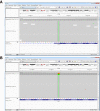Heterochronic triple primary malignancies with Epstein-Barr virus infection and tumor protein 53 gene mutation: A case report and review of literature
- PMID: 33644183
- PMCID: PMC7896647
- DOI: 10.12998/wjcc.v9.i5.1184
Heterochronic triple primary malignancies with Epstein-Barr virus infection and tumor protein 53 gene mutation: A case report and review of literature
Abstract
Background: The diagnosis and etiology of multiple primary malignant neoplasms (MPMNs) are difficult to establish. Here, we report a case of heterochronic triple primary malignancies with gastric cancer, nasopharyngeal squamous cell cancer, and then rectal cancer.
Case summary: The patient was first diagnosed with gastric cancer at the age of 33 in 2014 and underwent distal gastrectomy and gastrojejunostomy and six cycles of adjuvant chemotherapy. Three years later, he was diagnosed with nasopharyngeal cancer and treated with radical chemoradiotherapy in 2017. Recently, a mass in the middle of the rectum was resected and reported as ulcerative, moderately to poorly differentiated adenocarcinoma. Research on the etiology of MPMNs showed that Epstein-Barr virus (EBV) infection may be the cause of gastric cancer and nasopharyngeal squamous cell cancer since these two primary lesions were positive for transcripts of EBV-encoded ribonucleic acid using an in situ hybridization EBV-encoded ribonucleic acid probe in formalin-fixed, paraffin-embedded tissue. The cause of rectal cancer may be due to a somatic mutation of tumor protein 53 gene in exon 8 (c.844C>T, p.Arg282Trp) through high-throughput sequencing for the rectal cancer. Appropriate standard therapy for each primary cancer was administered, and the patient has no evidence of cancer disease to date.
Conclusion: To our knowledge, this is the first report on heterochronic triple primary malignancies whose cause may be associated with EBV infection and tumor protein 53 genetic mutations. The etiological research may not only elucidate the cause of MPMN but also has implications in clinical management.
Keywords: Case report; Epstein-Barr virus infection; Epstein-Barr virus-encoded RNA; Etiology; Multiple primary malignant neoplasms; TP53 mutation.
©The Author(s) 2021. Published by Baishideng Publishing Group Inc. All rights reserved.
Conflict of interest statement
Conflict-of-interest statement: The authors declare that they have no conflict of interest.
Figures







Similar articles
-
Exon 9 Mutation of PIK3CA Associated With Poor Survival in Patients With Epstein-Barr Virus-associated Gastric Cancer.Anticancer Res. 2019 Apr;39(4):2145-2154. doi: 10.21873/anticanres.13328. Anticancer Res. 2019. PMID: 30952761
-
[Detection of Epstein-Barr virus in lung carcinoma tissue by in situ hybridization].Zhonghua Shi Yan He Lin Chuang Bing Du Xue Za Zhi. 2007 Sep;21(3):288-90. Zhonghua Shi Yan He Lin Chuang Bing Du Xue Za Zhi. 2007. PMID: 17971949 Chinese.
-
Evidence for the association of Epstein-Barr Virus in breast cancer in Indian patients using in-situ hybridization technique.Breast J. 2018 Jan;24(1):16-22. doi: 10.1111/tbj.12828. Epub 2017 May 30. Breast J. 2018. PMID: 28557251
-
The oncogenic role of Epstein-Barr virus-encoded microRNAs in Epstein-Barr virus-associated gastric carcinoma.J Cell Mol Med. 2018 Jan;22(1):38-45. doi: 10.1111/jcmm.13354. Epub 2017 Oct 9. J Cell Mol Med. 2018. PMID: 28990284 Free PMC article. Review.
-
[Clinicopathology of Epstein-Barr virus-related gastric carcinoma].Nihon Rinsho. 1997 Feb;55(2):363-7. Nihon Rinsho. 1997. PMID: 9046824 Review. Japanese.
Cited by
-
High-grade serous papillary ovarian carcinoma combined with nonkeratinizing squamous cell carcinoma of the cervix: a case report.Front Oncol. 2024 Mar 7;14:1298109. doi: 10.3389/fonc.2024.1298109. eCollection 2024. Front Oncol. 2024. PMID: 38515573 Free PMC article.
-
Case report: Quadruple primary malignant neoplasms including esophageal, ureteral, and lung in an elderly male.Open Life Sci. 2022 Sep 16;17(1):1223-1228. doi: 10.1515/biol-2022-0465. eCollection 2022. Open Life Sci. 2022. PMID: 36185408 Free PMC article.
References
-
- Demandante CG, Troyer DA, Miles TP. Multiple primary malignant neoplasms: case report and a comprehensive review of the literature. Am J Clin Oncol. 2003;26:79–83. - PubMed
Publication types
LinkOut - more resources
Full Text Sources
Other Literature Sources
Research Materials
Miscellaneous

